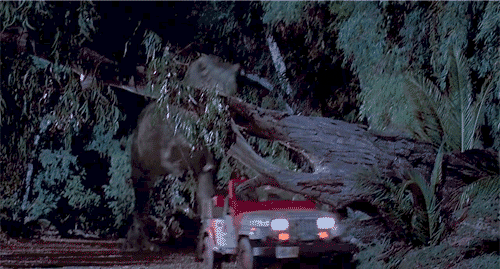Week 5: How to Outrun a T-rex

The Time Traveler’s Guide: How to Outrun a T-Rex!
Yes, this is how we will introduce this topic for the week. It is awesome! By the end of the week, you will know if scenes like this one and the original are accurate and why/why not.
Here are your Notes with Gaps and PowerPoint for this week.
First, How Dinosaurs Make Tracks
Some dinosaurs, like people, walk primarily on two feet, but others walk on all fours. So what do dinosaur tracks look like? Well, it depends on the dinosaur. in this section, we will focus on the trackways of 2 types of dinosaurs: Bipedal and Quadrupedal.
Next, Let’s Look at Some T-rex Tracks
With great difficulty, I set up some T-rex tracks for you to examine. Check out the video below and complete the first part of [Can You Outrun a T-rex?]
In the lecture videos I went over how animals with 2 vs 4 legs make different tracks. T-rex is a bipedal dinosaur, meaning it will only leave a maximum of 2 footprints for each set of steps it takes.
Watch the video below about the 3 various speeds at which T-rex tracks suggest they move.
Plug the information in the activity below into the equations in the T-rex Track Ways spreadsheet. Use the information in Column G to determine how quickly the T-rex is moving in each track set. Record your answers.
Could You Outrun a T-rex?
Finally, you will need to determine your walking and running speed to compare with T-rex. Check out the video below and complete the second part of [Can You Outrun a T-rex?]
[insert lecture video]
Part 2: Can you outrun it?
The gif above is from the original Jurassic Park movie. In this film they use a Jeep to easily outrun the T-rex. By the end of this exercise you will be able to gauge the reality of this scenario. You will also be able to determine if you could outrun the T-rex with your own 2 feet.
To complete this exercise you will need:
- a tape measure
- a long flat place where you can mark distances (like a sidewalk)
- a way to mark a start and end point (like chalk or flags)
Instructions:
- Measure out 5m (~16.4ft)
- Mark the start and finish lines of your 5m (~16.4ft)
- Walk the 5m (~16.4ft) length and count every time your lead foot (the one you took your first step with) hits the ground. Note: you should only be counting either your right foot or your left. Do not count them both.
- Record the number of times your lead foot hit the ground.
- Run the 5m (~16.4ft) length and count every time your lead foot (the one you took your first step with) hits the ground. Note: you should only be counting either your right foot or your left. Do not count them both.
- Record the number of times your lead foot hit the ground.
- Use the Stride Length formula to determine your stride length for walking and running.
- Plug your stride length into the equation to calculate your speeds in MPH.
- Compare these with the speeds T-rex can walk and run (based on the information provided above) using [LINK Can You Outrun a T-rex].
What is the result? Can you outrun a T-rex when it is walking? Jogging? Running?
Dino Tracks I Recently Visited!
For my birthday I went to Black Mesa in the northwestern portion of Oklahoma. there was a small set of Sauropod dino tracks there, but just over the border in New Mexico were some really great tracks. Check out the video I made of our trip.
[INSERT Dino Tracks_Vacay Footage]
Complete the following exercises this week:
- [Weekly Quiz 8a]
- [Can You Outrun a T-rex]
- [Weekly Quiz 8b]

